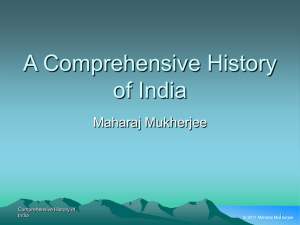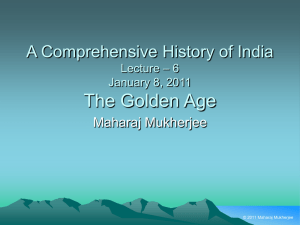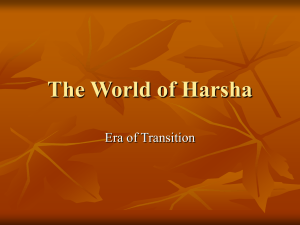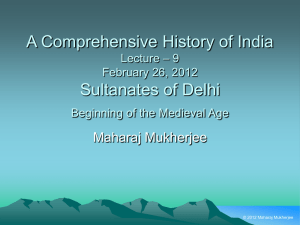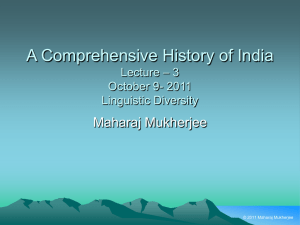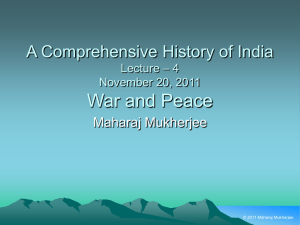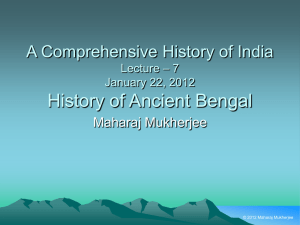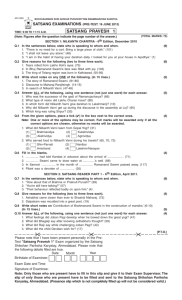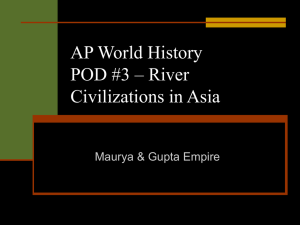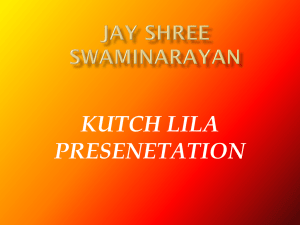Lecture 8 - Lipilekha
advertisement
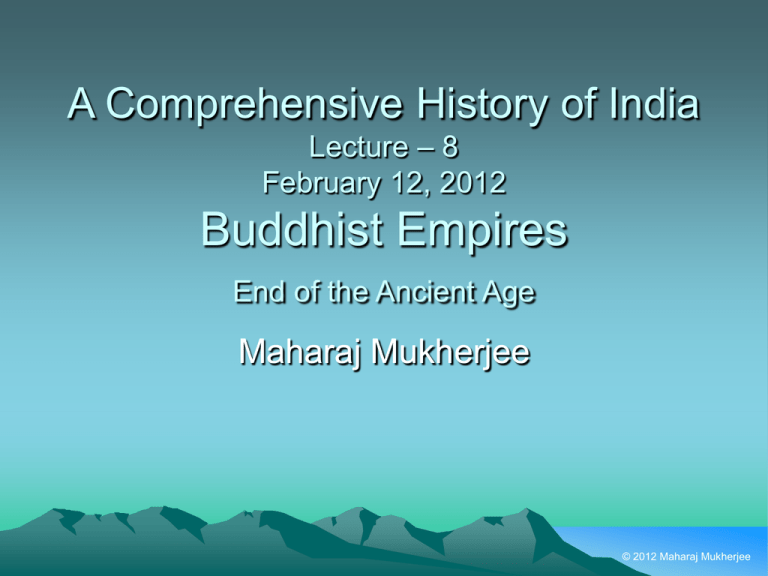
A Comprehensive History of India Lecture – 8 February 12, 2012 Buddhist Empires End of the Ancient Age Maharaj Mukherjee © 2012 Maharaj Mukherjee Recapitulation • Where we left off: Golden Ages (0 – 400/500AD) – Golden Ages of the Great Indian Thinkers • Arya bhatta, Baraha mihir, Bharkara Acharya • Kalidasa, Sudraka, Bisakha Dutta • Advancements of the Saka Tribes – The Kushan Dynasty • Kanishka (the king with the headless statue) • Started the Maha Yana Buddhism (god worshippers) – The Gupta Dynasty • Chandra Gupta – 1st, Samudra Gupta, Chandra Gupta – 2nd , Kumara Gupta • End of the Golden Ages – The Advancement of the Hun Tribes © 2012 Maharaj Mukherjee Map of India NORTH Himalayas WEST Bindhya Arabian Sea EAST Bay of Bengal SOUTH Indian Ocean © 2012 Maharaj Mukherjee End of the Gupta Empire (500 – 600 AD) • Hun-s established several small kingdoms in the North-Western part of India • Rest of the India were divided into small kingdoms • The kingdoms used to fight with each other all the time – – – – Stopped trade and progress of art and culture Travelling became difficult People’s life was at danger General chaos everywhere. © 2012 Maharaj Mukherjee The Buddhist Empires 600 – 800 AD • Even after 1500 years after Buddha’s death – India was still the center of Buddhism – Buddhist pilgrims from all over the world came to prominent places in India – Buddhist scholars from all over the world came to Indian universities to study • Buddhist Empires – Harsha’s Empire at Kanauj – Pala Empire at Bengal © 2012 Maharaj Mukherjee Harsha’s Empire • Harsha became king at a very early age. – After death of his brother Rajya Vardhan • He converted to Buddhism • He is known for his great charity – Used to donate his own expensive clothes that he was wearing and put on a simple cloth from his sister Rajyashree. © 2012 Maharaj Mukherjee Shashanka: The first historical Emperor of Bengal (590 – 626 AD) • Ruled over almost whole of Bengal – Anga, Banga, Kalinga • Arch enemy of Harsha – Killed Harsha’s brother Rajya in a war – Also fought many wars with both Harsha on the West and – Bhaskara the king of Kamrup on the East • Established the common Bengali Era or Bangabda (???) at 593 AD – Currently 1418 Bangabda • After the death of Shashanka, both Bhaskara and Harsha conqured Bengal and divided the whole kingdom between themselves – This created another 100 years of chaos in Bengal (650 – 750 AD) • This time is known as Matsanya – The rule of the fishes © 2012 Maharaj Mukherjee The Pala Empire The last Buddhist Empire in India 750 – 900 AD • The Pala empire started in Bengal – With kingdom in Gaur • The word Gaur is derived from the sugar syrup or Gur. – Main emperors of this era: • Gopala • Dharma Pala • Deva Pala © 2012 Maharaj Mukherjee Places of Buddhist Learnings • Nalanda Maha Bihar (University) – Become most prominent at the time of Harsha • Vikram Shila Maha Bihar (University) – Became most prominent at the time of Dharma Pala Vikram Shila Nalanda © 2012 Maharaj Mukherjee Exchange of Learning between India and Far East • Hiuen Tsang from China visited Nalanda at the time of Harsha – Kept a long record of the customs and rules about the life of Harsha • Sreegan Atish Deepankar went to Tibet to spread Buddhism in Tibet – He was the head of the Vikram Shila Maha Vihar (University) – Crossed the Himalayas to go to Tibet when he was 80. Hieuen Tsang Atish Dipankar © 2012 Maharaj Mukherjee Different Eras of History • Pre historic Ages – Time before the recorded history (15000 BC – 700 BC) – Hunter Gatherer, Indus Valley, Aryans, Time of the Epics • Ancient Ages – Time of initial recorded history (700 BC – 900 AD) – We just finished studying the ancient ages • Middle Ages – We will start from the next class • Modern Ages – Time we are living in now © 2012 Maharaj Mukherjee © 2012 Maharaj Mukherjee
